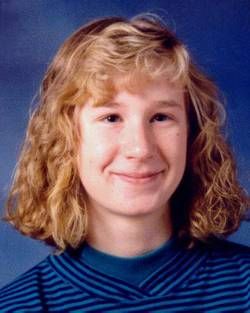Eltűnt Gyerekek nyomába - Missing children
Olyan oldal, ahol eltűnt gyerekeket mutat be, hátha lesz olyan valaki, aki rátalál. this is the page where you present missing children.

- Missing Since09/17/1992
- Missing FromTacoma, Washington
- ClassificationNon-Family Abduction
- SexFemale
- RaceWhite
- Date of Birth03/10/1978 (42)
- Age14 years old
- Height and Weight5'8 - 5'9, 105 - 120 pounds
- Clothing/Jewelry DescriptionA navy blue pullover sweatshirt, baggy light blue stonewashed jeans with funky stitching and rolled-up cuffs, brown suede shoes and a gold ring.
- Distinguishing CharacteristicsCaucasian female. Blonde hair, green eyes. Misty has a mole under her right eye and a scar underneath her right knee. She has previously fractured both forearms. One of her teeth has a root canal and three other teeth have fillings.
Misty was last seen walking to her family's residence in the Tacoma, Washington area on September 17, 1992. She was returning from the Puyallup Fairgrounds in Puyallup, Washington at the time; she had gone there with a close friend, Trina Bevard.
Misty missed the 8:40 p.m. Pierce Transit bus back to her neighborhood in Spanaway, Washington. She called her mother and said she might get a ride with Rheuban Schmidt, an eighteen-year-old friend. Misty's mother didn't trust Schmidt and told her daughter to find someone else to help her.
Misty eventually decided to walk home, a distance of eight miles. A witness saw her at 10:00 p.m. in downtown Puyallup, walking along Meridian toward the westbound onramp of Highway 512. She never arrived home and has not been seen again. She is not believed to have been carrying any money at the time of her disappearance.
Misty's mother reported her missing the next day, after she contacted relatives and Misty's friends and found out none of them knew where she was.
Schmidt said she had asked him for a ride the night before, but he didn't have enough gasoline. His roommate said Schmidt left shortly after the phone conversation. The roommate thought Schmidt had gone out to pick up Misty, but Schmidt denied the story and maintained he hadn't seen her and didn't know her whereabouts.
Police initially assumed Misty had run away from home. One female classmate claimed Misty called her after her disappearance and said she was okay, and another classmate said she thought she saw her on September 21.
Both witnesses knew Misty only slightly, but based on their evidence, authorities closed the case and falsely informed the media that Misty had been found. They refused to reopen the investigation for weeks.
It wasn't until December 1992 that police acknowledged Misty might have met with foul play, and it wasn't until five months after her disappearance that they interviewed Brevard and Schmidt, the last two people known to have seen her.
When she was interviewed, Brevard said Schmidt was supposed to take her and Misty home from the fairgrounds that evening. He told them he couldn't pick them up because he didn't have enough fuel.
Misty called him back and told him how to get inside her house so he could get money and buy gasoline. Schmidt still refused to come, however, saying he didn't even have enough gas to get to Misty's house, which was six miles from his own home.
After that, Brevard said, the girls decided that she would walk home and Misty would take the bus. Brevard stated she and Misty parted ways at approximately 8:45 p.m.
Police later discovered Brevard had lied about part of her story. She hadn't walked home; her 23-year-old boyfriend, Michael J. Rhyner, had picked her up. He had no criminal history as an adult, but at sixteen he was accused of abducting and raping an eleven-year-old girl at knifepoint. No charges were filed in that case.
Brevard stated she offered to let Misty ride with her and Rhyner, but Misty didn't trust him and refused to come with them. Brevard said Rhyner dropped her off at home and she told him Misty had taken the bus.
Police theorized Rhyner returned to the fairgrounds later and convinced Misty to get into his car, but Rhyner denied this, and he later passed a polygraph and was eliminated from the investigation.
When police questioned Schmidt, he confirmed Brevard's story but said he had suffered from blackouts for most of his life and couldn't remember anything that happened after the second phone call from Misty. He said he woke up the next morning, alone at his grandmother's farm near Enumclaw, Washington.
When investigators asked if it was possible he blacked out and harmed Misty, he answered, "I don't know." Schmidt took a polygraph exam, but it was inconclusive and authorities felt he was trying to influence the results.
Investigators conducted periodic searches for Misty throughout the remainder of 1992 and into 1993. A small private search party discovered her underwear, jeans, shoes and one of her socks on February 7, 1993, nearly four months after her disappearance. She had worn those clothes on the day of her disappearance.
The clothes were covered in mud and rolled up in a ditch near the intersection of State Highway 410 and Weyco Road, near the Mud Mountain Dam area. It appeared as if they had been exposed to the elements for a long time.
Laboratory analysis showed there was no blood or semen on the clothing, but there were three red paint chips on the jeans. The paint chips have since been lost.
Misty's hair pick and toothbrush were located on February 20, 1993, approximately one-half mile from the location of her clothes. She carried both the items in her purse at the time of her disappearance. In 2009, police completed a DNA test on the jeans; curiously, the DNA didn't match Misty, but came from an unidentified male instead.
Witnesses reported Schmidt had said he knew where Misty's body was: he said it was six miles from where her clothes were found. Schmidt's grandmother's farm, where he said he was the morning after Misty disappeared, is six miles from the Highway 410 ditch where the searchers located her clothes.
Schmidt admitted to making the statements, but said they were untrue and he'd made them up to get people "off his back." He agreed to take a second polygraph, and this time he passed.
Authorities continued to view Schmidt as a person of interest in Misty's case, however. In 1996, one of her friends accused him of rape, but after two weeks she refused to press charges. He was convicted of theft in 2000, and his wife got a domestic violence protection order against him in 2006, saying he'd threatened to kill her and burn down her house.
An area man, Cory Bober, was very interested in the Green River Killer, a serial murderer responsible for the murders of numerous girls and women, many of them prostitutes, in King County, Washington in the 1980s.
He had a suspect in mind and persistently pursued law enforcement with his ideas. The suspect was later charged with child rape, but he was not the Green River Killer; Gary Leon Ridgway pleaded guilty to the 48 Green River killings in 2003.
Bober believed the still-unsolved murders of Kimberly DeLange, 15, and Anna Chebetnoy, 14, were connected to the Green River case. DeLange disappeared in 1988 and her body was found later that year. Chebetnoy vanished in 1990, and her remains were found in 1991. Both teens from the same Puyallup shopping center, and their bodies were found within 100 feet of one another.
Because those girls were killed two years and one month apart, Bober suggested another victim would be murdered two years and one month after Chebetnoy, and Misty did disappear at that time. Bober got in touch with Misty's mother shortly after her disappearance and told her his theory.
He maintained contact with her for years, and it was he who suggested the search the Highway 410 area where Misty's clothes were located. This location is only about a ten-minute walk from where DeLange and Chebetnoy's bodies were found. Investigators believe the teens' homicides and Misty's disappearance may be related.
Bober's behavior led both police and Misty's mother to suspect he was involved in her disappearance. He maintained his innocence and agreed to take a polygraph, but then canceled the test.
He has no criminal history of violence or sex offenses, but he did serve time in prison on drug charges after Misty went missing. He isn't considered a serious suspect in Misty's case, as he has a partial alibi for the night she went missing, he is agoraphobic and he has never held a driver's license. He continues to advocate for a resolution in Misty's disappearance.
There has been no trace of Misty since her belongings were located, although an unconfirmed report did place her somewhere in northern Minnesota shortly after her disappearance.
She was an excellent student in 1992, and played softball, basketball and volleyball. She didn't drink or use drugs, wasn't sexually active, wasn't having problems at home and had no history of runaway behavior. Her parents divorced shortly after she was born and she lived with her mother in 1992. Both her parents passed polygraphs and are not considered suspects in her case.
Misty is described as a conscientious and level-headed but naive teenager. Her mother and the police believe she met with foul play, possibly at the hands of a serial killer. In May 2000, the Pierce County Medical Examiner's office issued a death certificate for her, though her remains have not been found. Misty's case remains unsolved.
-----------------------------------
A honlap ára 78 500 helyett MOST 0 Ft.
Honlapkészítés ingyen:
Ez a weblapszerkesztő alkalmas
ingyen weboldal,
ingyen honlap készítés...
Honlapkészítés ingyen:
Ez a weblapszerkesztő alkalmas
ingyen weboldal,
ingyen honlap készítés...
Weblap látogatottság számláló:
Mai: 29
Tegnapi: 76
Heti: 373
Havi: 766
Össz.: 182 608
Látogatottság növelés
Mai: 29
Tegnapi: 76
Heti: 373
Havi: 766
Össz.: 182 608
Látogatottság növelés
Oldal: MISTY DONNA COPSEY
Eltűnt Gyerekek nyomába - Missing children - © 2008 - 2026 - missingchildren.hupont.hu
Eltűnt Gyerekek nyomába - Missing children - © 2008 - 2026 - missingchildren.hupont.hu
